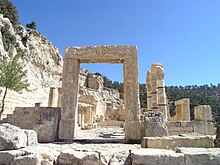Alahan Monastery
The Alahan Monastery ( Turkish Alahan Manastırı ) is an early Byzantine ruins in the ancient mountainous landscape of Isauria , part of Cilicia . It is 11 km north of Mut , 2 km above the modern road from Silifke to Karaman in the Mut district of the Turkish province of Mersin .
Its location on the southern slope of a rocky ridge at approx. 1200 m altitude above the valley of Kalykadnos with a wide view and the good preservation of its buildings make it one of the most impressive ancient sites in Asia Minor .
Coordinates: 36 ° 47 ′ 29 ″ N , 33 ° 21 ′ 7 ″ E
Surname
The ancient name of the place is not known. Hild and Hellenkemper suggested to Apadnas that, according to Prokop , De Aedificiis 5, 9, 33, Emperor Justinian I had an Apadnas monastery restored in Isauria; however, there is insufficient evidence to link this monastery with Alahan.
The village below the church complex is referred to by the Ottoman traveler Evliya Çelebi and the French archaeologist Léon de Laborde (1807–1869) as Alaca Han ( The multi-colored Han ). At the end of the 19th century the place was called Koca Kalesi . Since the middle of the 20th century, the common name Alahan has been Manastırı ( Alahan Monastery ).
buildings
A whole complex of connected buildings from the end of the fifth century has been preserved in Alahan. In the far west are the remains of the once three-aisled , so-called Evangelist basilica , which replaced a previous building from the fourth century. From the narthex Little remains, but the frame of the three monolithic blocks existing portal , rich with Akanthusreliefs and figurative motifs decorated. Two hovering angels hold a medallion of Christ on the lintel . A creature with four wings and four heads, a so-called tetramorph , is depicted on its underside, while the archangels Gabriel and Michael are depicted on the inside of the pillars . Further to the east are the remains of the two-aisled baptistery with a Byzantine cross as a baptismal font, followed by a small oratory . A 130 m long portico leads to the main church in the far east, an almost completely preserved domed church (apart from the missing roof). The frames of the three entrance portals are decorated with tendril and fish motifs. The main and side aisles are in yokes divided and columns with Corinthian capitals divided. The square yoke in front of the apse was domed , corner trumpets and pillars on consoles form the transition from the square to the dome . The conical apse, which contains a three-tier synthronon , is illuminated by a two-part arcade window . In front of the church there are some rock tombs and sarcophagi .
Research history
Alahan is mentioned for the first time by Evliya Çelebi in the late 17th century; he describes the complex as “a structure that was recently handed over by the architect”. The British archaeologist Michael Gough began his research and excavations here in 1952, which ended with his death in 1973. From 2002 to 2006, as part of the British Göksu Archaeological Project under the direction of Hugh Elton , research took place in Alahan and above all in its vicinity.
literature
- Arthur C. Headlam : Ecclesiastical Sites in Isauria (Cilicia Trachea). London 1892 ( digitized ).
- Paolo Verzone : Alahan Monastir. Un monumento dell'arte Tardo-Romana in Isauria. Turin 1956.
- Nicole and Jean Michel Thierry : Le monastère de Koca Kalesi en Isaurie. In: Cahiers Archéologiques. Vol. 9, 1957, pp. 89-98.
- André Grabar : Deux portails sculptés paléochrétiens d'Egypte et d'Asie Mineure et les portails romans. In: Cahiers Archéologiques. Vol. 20, 1970, pp. 15-28.
- Angelika Geyer : Aspects of architectural ornamentation by Alahan Monastir. In: Yearbook for Antiquity and Christianity . Vol. 27-28, 1984-85, pp. 151-170.
- Mary Gough (Ed.): Alahan. An early Christian monastery in southern Turkey. Based on the work of Michael Gough. (= Pontifical Institute of Mediaeval Studies. Studies and texts. Vol. 73). Toronto 1985, ISBN 0-88844-073-1 .
- Friedrich Hild , Hansgerd Hellenkemper : Kilikien and Isaurien. (= Tabula Imperii Byzantini . Vol. 5). Vienna 1990, pp. 193–194.
- Cyril Mango : Germia: A Postscript. In: Yearbook of Austrian Byzantine Studies . Vol. 41, 1991, pp. 297-300.
- Stephen Hill: The early Byzantine churches of Cilicia and Isauria. Variorum, Aldershot 1996, ISBN 0-86078-607-2 , pp. 68-83.
- Stephen Hill: Alahan and Dağ Pazarı. In: Ancient Anatolia. Fifty years' work by the British Institute of Archeology at Ankara. London 1998, pp. 315-337.
- Hugh Elton: Alahan and Zeno. In: Anatolian Studies. Vol. 52, 2002, pp. 153-157.
- Alexandra Ricci: Alahan, di nuovo. In: Rivista dell'Istituto Nazionale di Archeologia e Storia dell'Arte. Vol. 66 = 3rd series 34, 2011 [2015], pp. 37-48 ( digital copy ).
- Marianne Mehling: Knaur's cultural guide: Turkey . Droemer Knaur Munich / Zurich 1987, pp. 53–54, ISBN 3-426-26293-2 .


